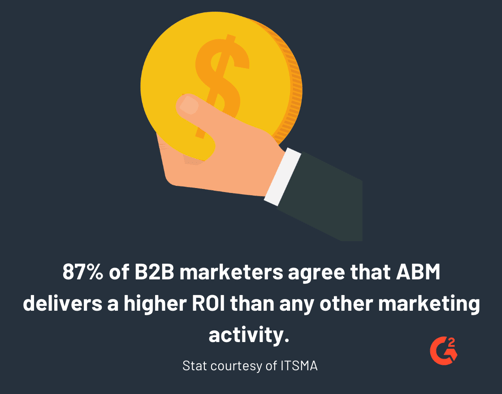One of marketing’s biggest challenges has always been justifying a budget.
Account based marketing (ABM) provides the right revenue-accountable environment for marketers to justify and optimize their marketing investments.
What is account based marketing?
Account based marketing is a strategic approach in which you base your marketing on the specific needs of the account you are targeting. This strategy is often used to acquire a specific high-value customer.
ABM is only as powerful as a marketer’s ability to identify and deliver consistent, relevant messages across communication channels.
However, when used correctly, the results can be positive. In fact, 87% of B2B marketers agree that ABM delivers a higher ROI than any other marketing activity. Research has shown that 84% of organizations that have successfully implemented an ABM strategy report improvement in their reputation and 74% report improvements in their business relationships.

Account based marketing tactics
To maximize engagement and revenue, your platforms need to work together, both in timing and content strategy. If you’re considering ABM, here are a few account based marketing tactics to craft your strategy around.
1. Direct mail
Direct mail has stepped out of the shadows of digital advertising in recent years, and combining it with your digital ads could significantly improve response rates. Connected to your marketing tech stack, direct mail messaging can provide the capability of coordinating content and timing across multiple channels. More than a one-off letter or new silo of activity, direct mail messaging can offer the flexibility of form, from customized gift card mailers to high-value dimensional pieces, and the power of being an integrated component of an overall account-based strategy.
Want a more streamlined process for sending direct mail? Check out G2’s best direct mail automation software that will make the process of tracking, targeting, and sending letters.

2. Email
When email is assimilated as an integral component of an ABM strategy, it can connect the scale of marketing automation to the power of account based marketing orchestration. Email’s real value lies in two key features: an immensely ROI-friendly deployment and its high degree of consumer preference. Moreover, email has survived multiple disruptions in channel communications and managed to come out on top, delivering real results and continuing to be the steady workhorse for B2B marketers, out-performing everything else from social media to paid search.
Despite this long-standing reliability, email hasn’t remained static as it continues to evolve in the age of data. It is a data-rich channel that helps marketing and sales teams become more effective by providing a canonical view of every account relationship. Combined with ABM, email can collect, collate and track data from lists, segments, and accounts to funnel stage and revenue impact with ease.
3. Content syndication
When selected rationally, content syndication can provide your business with the knowledge to extend the reach of your organization’s content and greater insights that refine your go-to-market strategy. When searching for a syndication partner, it is critical to find a provider that knows how to correctly segment audiences and connect with the right audience at the right time. While numbers matter, locating a big audience shouldn’t take precedence over finding the right audience. Combining the ability to test and optimize email copy, content assets, and subject lines all mid-campaign helps increase conversion rates.
Conversion is probably one of the most important aspects of any B2B content syndication program. Content syndication requires a multifaceted approach in order to implement a successful program. When searching for a content syndication vendor, your partner should not only understand the type of content that is appropriate for each stage of the sales cycle, but they should also be well versed in the best practices for creating a high conversion strategy for lead generation.
4. Display advertising
Account based advertising forms an integral part of any account-based marketing strategy and uses digital display advertising campaigns to target relevant accounts with the most revenue potential. Account-based advertising doesn’t just begin and end with advertising. It is designed to coordinate messaging and tactics based on an account’s specific pain points. You can’t measure the ROI of account based display purely from direct conversions. This is the last click mentality. What you need is a strategy which can tie display metrics back to other channels, pulling it outside of its silo. If the message is creative and gets a response, then having the best ad creative seems to be a rather important feature for an account-based advertising vendor, right?
This is a critical decision point for your ABM display ad program. Will your media reflect the needs of each target account? Can you test creatives to find the right message? ABM is used to create media that reflect the ever-changing needs of each target account. Personalization is about the audience, and your media should be too.
5. Predictive marketing
Somewhere, your audiences are already searching for things that you could solve. Searches, clicks on ads, documents read, and pages visited all serve as clues, but almost all of them exist somewhere outside of your view. That is, until you utilize predictive analytics.
To succeed with account based marketing, a solid data foundation is essential. Predictive analytics identify the accounts that are most likely to buy. One of account based marketing’s greatest advantages is the ability to deliver messaging that target accounts that will actually engage with it. Making your message meaningful is much easier if you have the insights to know who you are targeting and what they will respond to. From lists and segments to accounts and revenue impact of certain tactics, predictive analytics helps you understand who to target and which message to deliver to have the greatest impact. More than a simple view into a platform or econometric assumptions of smaller attribution systems, rich analytics can provide the right revenue accountable environment for marketers to justify and optimize their ABM investments.
6. Avoiding ABM silos among data points to trigger action
The convergence of artificial intelligence and machine learning with marketing tactics has been proven to enable smarter customer engagement and better results. Using data collected from your customer’s journey will give you a complete view of the purchasing patterns behind each customer account you have. Utilizing machine learning algorithms that combine customer intent signals and pre-purchase research patterns with past practices and behaviors offers you a complete view of your long-term customer intent. Not only will this assist your engagement strategy, but you’ll also be able to see what worked, what didn’t, and what needs improvement. Your strategy gets smarter with every sales cycle.
Customize your marketing
The timing, needs, and interests of each target account are varied and complex, but knowing and acting on them is the one thing that can drive revenue impact to your ABM program. Account based marketing can be the silver bullet to cut through the noise across multiple channels, enabling targeting of the right accounts, at the right time, within the right context. To achieve this, ABM must be much more than just a list of accounts and a new stream of media or messages. It cannot work in isolation, nor can it be a channel-based point solution.
Want to read more marketing-centric content? Check out our guide on the four types of market segmentation!
 by Michael McGoldrick
by Michael McGoldrick
 by Priyanka Desai
by Priyanka Desai
 by Joel Garcia
by Joel Garcia